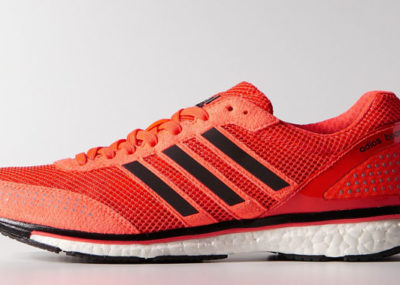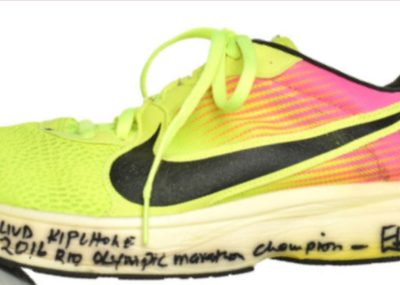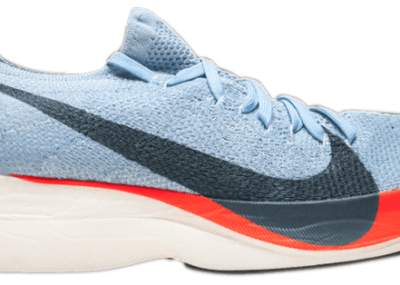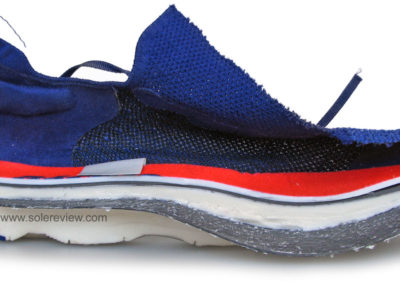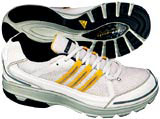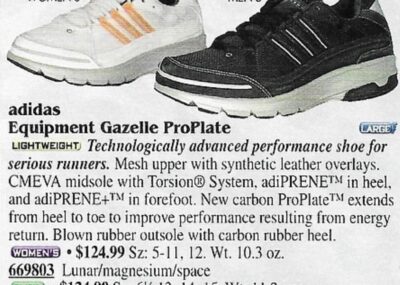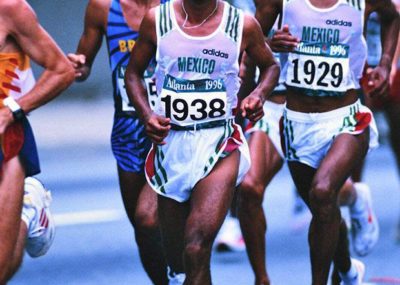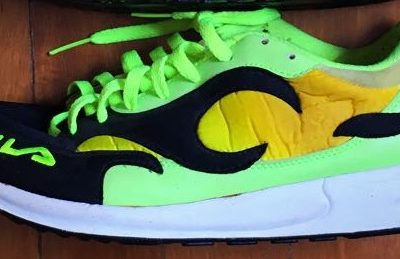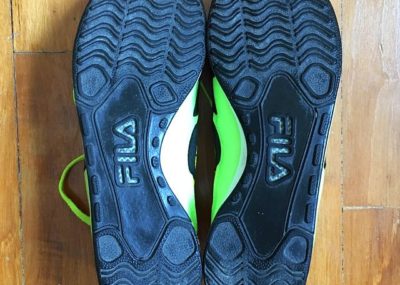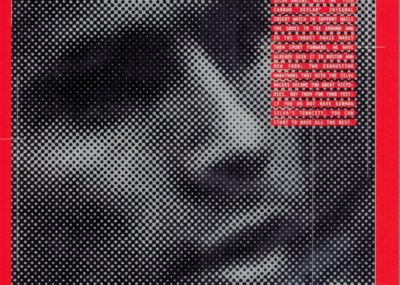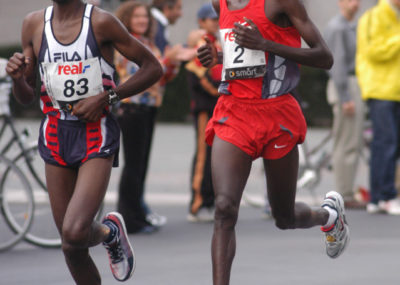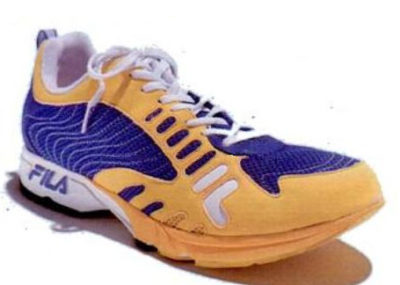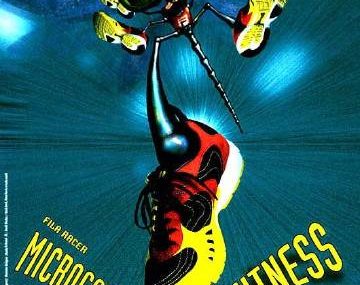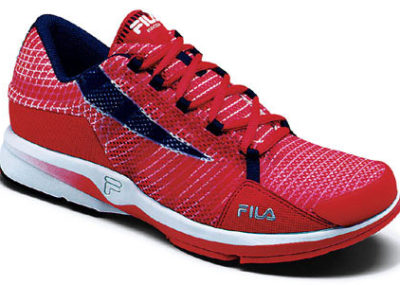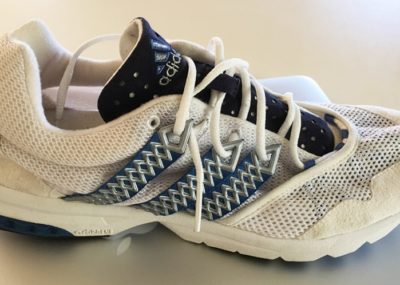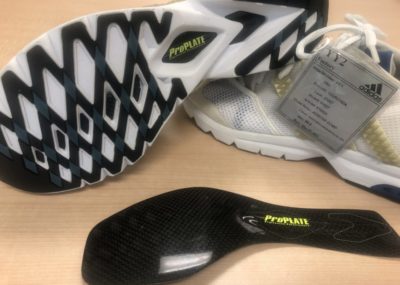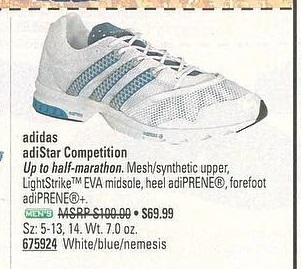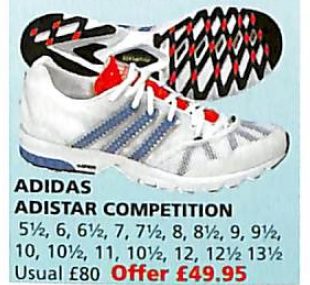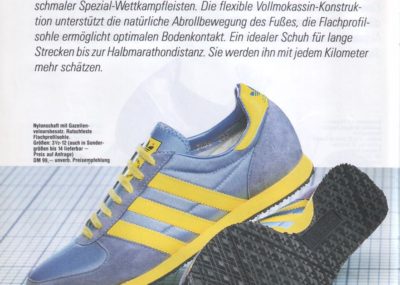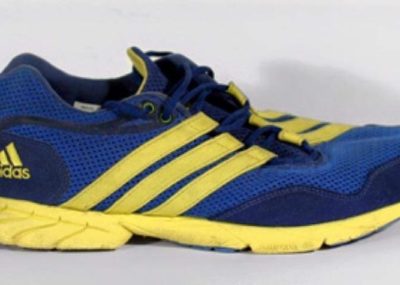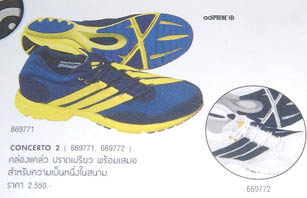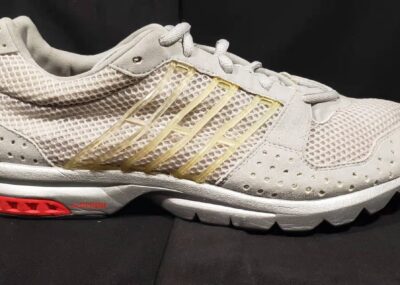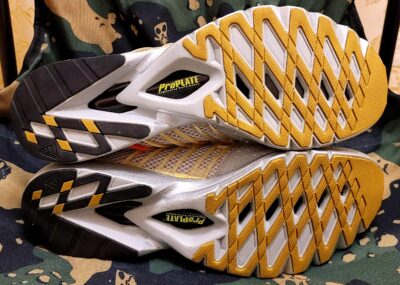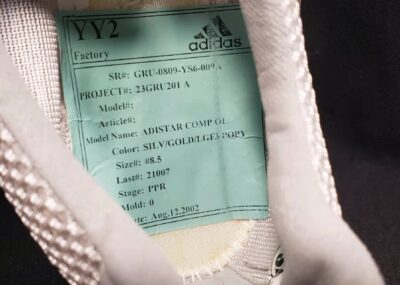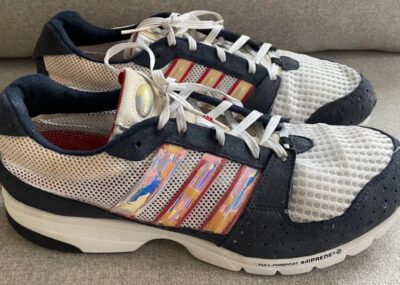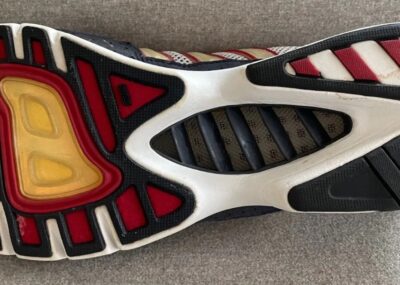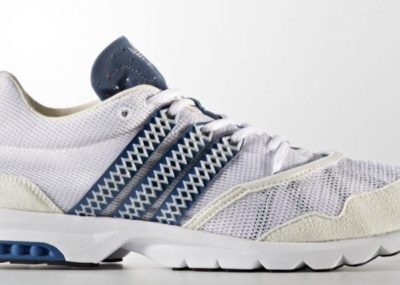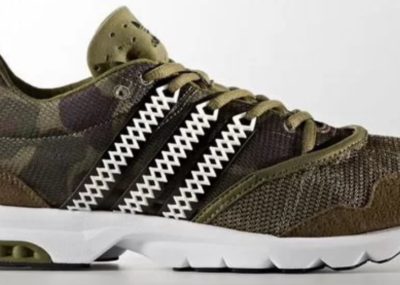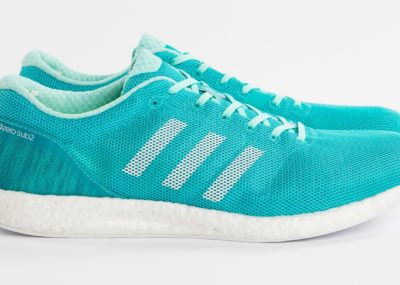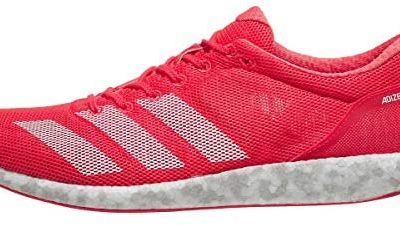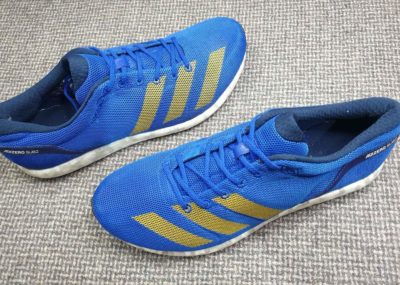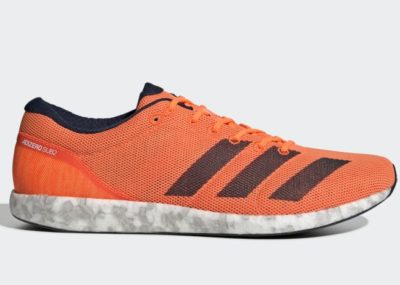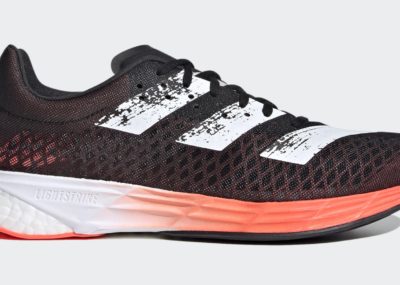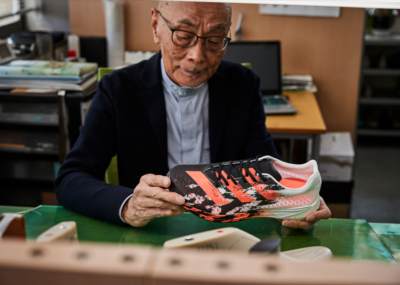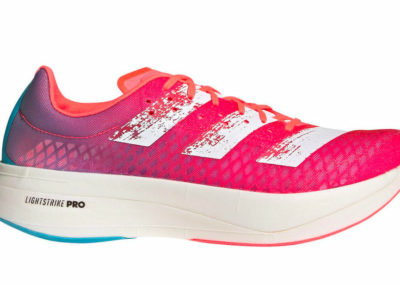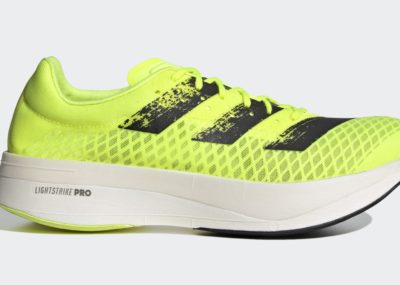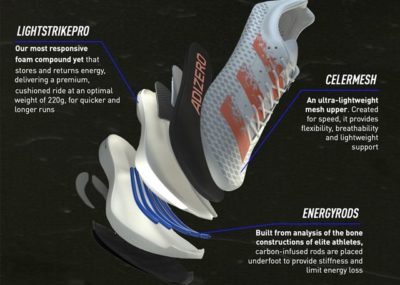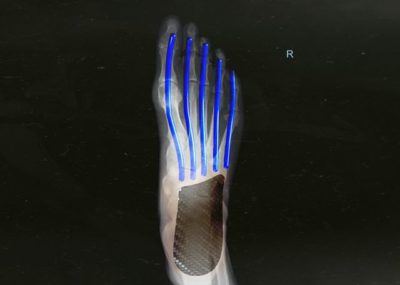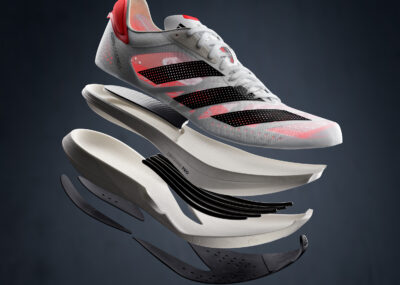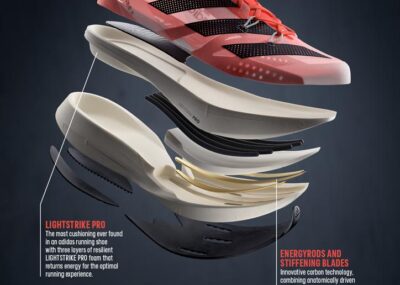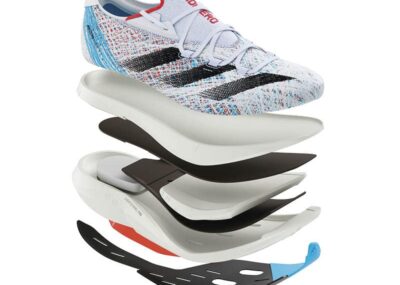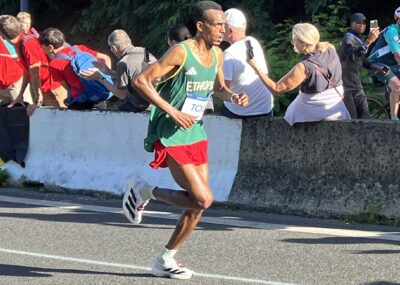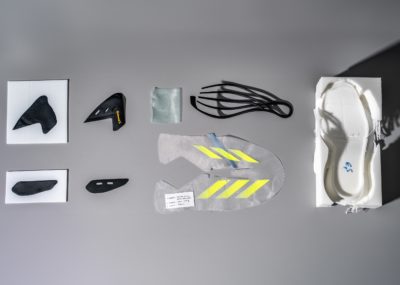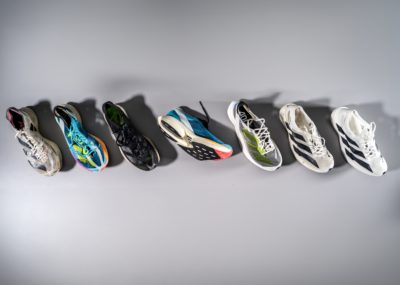1. When Adidas first tried carbon-fibre
Adidas was at the top of the running world in 2016. Thanks to the heroics of Dennis Kimetto it was shoes bearing the three stripes that had helped set the marathon world record, specifically the AdiZero Adios Boost 2. Since that previous year however, athletes sponsored by Nike could be seen sporting footwear with an unusually thick midsole.
| Embed from Getty Images | Embed from Getty Images |
Come 2016, Eliud Kipchoge would win the marathon at the Olympics in dominant fashion wearing similar Nike shoes. Later that year, Nike would announce that they were planning to break the two hour marathon barrier with some of the top distance runners, including Kipchoge. In March 2017, Nike revealed the weapon they would use: the brand new Zoom VaporFly equipped with a specially curved carbon-fibre plate. Adidas knew it had to respond, but the direction they took had in many ways been set two decades earlier.
The University of Calgary is known for its connections to the footwear industry, especially its Faculty of Kinesiology, and was in many ways the birthplace of the Nike Zoom VaporFly. Those ideas however were in fact first applied to an Adidas shoe. Within that faculty lay the Human Performance Lab, where at that point in time the University of Calgary was working with Adidas. Dr Darren Stefanyshyn, then a PhD student, focussed his thesis on ways to improve athletic footwear. With his supervisor Dr Benno Nigg, they found that running shoes acted as absorbers of energy.
Their solution was inserting a carbon-fibre plate, which would stiffen the shoe and reduce this energy loss. Adidas started working with Stefanyshyn in 1998 on how to implement the idea into practice. Their solution was called the Pro Plate. Their first shoe was the Adidas Equipment Gazelle Pro Plate released in 2001. Weighing in at 322 grams, it was designed as an everyday trainer with the carbon-fibre plate helping make longer runs smoother and easier.
2. Roman holiday
One of their biggest rivals at this time, both technologically and competitively, was in fact Fila. The Italian company was in fact the first to place a carbon-kevlar plate within the confines of a racing flat. To fully explain how they introduced this innovation, we must go back to 1991. This was when the combined talents of Dr Gabrielle Rosa and Moses Tanui joined forces. Dr Rosa had coached many successful athletes including 1986 New York City Marathon winner Gianni Poli, while Tanui was rising up the ranks of middle-distance running competition.
Both men wanted to create more opportunities for Kenyan athletes, with the likes of Douglas Wakiihuri already flying the flag proudly for the nation. The program was named Discovery Kenya, and Fila came on board to provide sponsorship. Fila was experiencing enormous growth at the time, and was looking for new ways to build the momentum.
It would find another such opportunity in an environment that could not have been more different to Kenya. In 1991, Italian mountaineer Marino Giacometti organised an event that had him competing over 52 kilometres up and down part of Mont Blanc. After some articles referred to the competitors as ‘runners of the sky’ the term Skyrunner and Skyrunning stuck. In essence, it blended trail running with mountaineering.
Fila were clearing captivated by the concept, and by 1993 put their money behind Giacometti to arrange yet more events. With the assistance of local businesswoman Lauri van Houten they held their first formal race under the new banner. It was around this time where they considered how to make trail running shoes more suited for these unique conditions. Many years later their solution would be to insert a carbon-kevlar plate within the shoe to provide both stability and propulsion. Unfortunately finding more information on their development has proven difficult, however I’ve been advised that Giacometti is writing about the history of Skyrunning, including his work with Fila, for release soon. Hopefully this will help shed some light on this exciting period of athletic history.
In 1995, Giacometti and van Houten launched the Federation for Sport at Altitude, which was also the first year such an event would be held in Kenya at Mount Kenya. The organisation eventually became the International Skyrunning Federation in 2008, and has continued to grow since then with events across the world. Back in America, Fila were taking steps that would establish it as the second biggest basketball shoe company behind Nike, signing Grant Hill to their growing roster of endorsed athletes. Fila was only behind Nike and Reebok in terms of overall sales for athletic footwear. The company wanted to keep diversifying, and was looking for more opportunities to do exactly this.
It was Mexican distance running legend Germán Silva who presented such an opportunity. He won the famous New York City Marathon in both 1994 and 1995, in the former having famously come back after turning the wrong way in the last second. On his feet were clean white Fila racing flats. The company now had the unique opportunity of getting its product in front of the eyes of the world, and in particular America, when the 1996 Olympics would be hosted in Atlanta.
Fila decided to place carbon-kevlar plates within a racing flat silhouette. It was named the Silva Racer. The distinctive shoe, featuring black flames against its neon yellow upper, could not have been more different to the white shoes Silva had worn as recently as the 1996 London Marathon. They were provided to other runners as well, including Ezekial Bitok of Kenya who had shown considerable promise in cross country competition.
Silva surged momentarily to the lead at the end of the first third of the event, and was still only twenty seconds away from the leaders with just over four kilometres left. Unfortunately he would eventually fade to sixth in gruelling conditions, but not without his bright yellow shoes getting considerable time in front of the cameras. More potential was there to be unlocked.
Under the guidance of newly hired Filippo Pavesi, who was given responsibility for research and development, they improved and perfected the concept. The stage was set for the wider commercial release of the Fila Silva Racer in 1997. The launch was marked by print and television campaigns, underlining the new product and direction for the company.
Success for the Fila Silva Racer was almost immediate. Elijah Lagat won the 1997 Berlin Marathon, and Moses Tanui secured victory at the 1998 Boston Marathon. Tanui had already won the 1996 running of the event and in 1993 he became the first man to ever run the half-marathon in under one hour. As for their most recent achievements, both Lagat and Tanui had worn the Silva Racer.
3. Fila Racer
Fila hardly rested on their laurels, neither could it afford to. While sales reached their highest ever in 1997, flagging interest in the company’s basketball line were catastrophic. Across 1998, sales dropped by almost half. Later that year, some of their athletes could be seen sporting a brand new shoe. This was the Fila Racer. The updated carbon-fibre plate technology was dubbed Speed Tech.
Embedded within EVA foam, it was relatively low profile, with contemporary reviews talking about how the technology helped make the shoe smooth to run in i.e. it helped the runner through the transition of their gait. The first version even had the carbon-fibre plate partially exposed underneath the shoe, the second version extending the plate further along the midsole. The package came in at 218 grams.
Come 1999 it was used to further stamp the brand’s authority on distance running. Joseph Chebet won both the Boston Marathon and New York City Marathon, while Josephat Kiprono took the win at the Berlin Marathon. Elijah Lagat won the 2000 Boston Marathon, Simon Biwott the 2000 Berlin Marathon, with the legendary Paul Tergat taking both the 1999 and 2000 World Half-Marathon Championships. All wore the first version of the Fila Racer in various colourways along with the distinctive uniforms of the Discovery Kenya program. By 2001, Fila would be sponsoring as many as 250 Kenyan athletes through the Discovery Kenya program and was operating six major training camps in the country.
Margaret Okayo was arguably the most successful of them all. She won the New York City Marathon in 2001 and 2003, the latter setting a course record that still stands today. There was also her victory in the 2002 Boston Marathon, setting the course record on the notoriously difficult course which stood until 2014 and is still the 4th fastest time ever. Finally there was her win at the 2004 London Marathon. All of these victories were secured with the first version of the Fila Racer.
The next version of the shoe came out in 2002, dubbed the Fila Racer K1. The carbon-fibre plate was extended further along the shoe, and the upper swapping to more breathable synthetic fabrics. These changes only resulted in minor weight penalties, the new model weighing 243 grams. It would continue the winning formula established by its predecessors.
Raymond Kipkoech won the 2002 Berlin Marathon, Robert Kipkoech Cheruiyot the 2003 Boston Marathon, and Martin Lel the 2003 New York City Marathon as well as the World Half-Marathon Championships. The Fila Racer K1 featured on their feet on each occasion. The only achievement that Fila and their cadre of athletes had not secured was the marathon world record.
Tergat had set what appeared to be the half-marathon world record of 59:06 in 2000 at the Lisbon Half Marathon. That course however is considered by World Athletics to be too steep for an official world record, similar to the Boston Marathon course which you can read about here. It was Sammy Korir who came agonisingly close to giving Fila the world record in the classic distance. In the closing stages of the 2003 Berlin Marathon misfortune befell Tergat, now wearing Nikes, when he took a longer than ideal line approaching the Brandenburg Gate.
Korir had originally started the race as one of the pacers, but was now closing in and on track to set the new marathon world record. Tergat responded, beating Korir to win by only one second. He set the new marathon world record of 2:04:55, which meant the Fila Racer K1 was the second fastest marathon shoe in the world. Given that the Nikes worn by Tergat were prototypes, which you can read more about here, the Fila Racer was also the fastest such shoe commercially available.
| Embed from Getty Images | Embed from Getty Images |
What stopped Fila in its tracks had little to do with their success in competition. They were simply unable to convert this success and considerable sponsorship investment into shoe sales, despite early commercial promise for the Fila Racer. In 2003 the company was finally sold on to an American hedge fund. The assets would be sold again to Fila Korea, its former subsidiary, in 2007. The new management would eventually reinvigorate the brand and bring it back to success, but that’s another story.
If you would like to know more about how Fila pioneered this technology in racing flats, as well as some of the other fascinating shoes that they developed during this period, I have since written an article about this which has been published by Marathon Handbook.
4. The Adistar Competition
Adidas took what it had learned and put it into the Pro Plate into a more lightweight package. In 2003 they released the result of their work, the Adidas Adistar Competition. Adidas kept weight down to 225 grams, immediately taking the shoe into far more competitive territory. One review at the time spoke of how smooth the ride was, and from pictures you can see the Pro Plate is sitting near the top of the midsole. Studies by the University of Calgary found the shoe could result in energy savings of one percent compared with more traditional running shoes.
The concept had already proven its worth on the feet of the legendary Haile Gebrselassie, who wore prototypes of the Adistar Competition at the 2001 IAAF World Half Marathon Championships. In only his second attempt at the distance, having already won on his debut, he would win again and in 1:00:03, one solitary second ahead of countryman Tesfaye Jifar.
| Embed from Getty Images | Embed from Getty Images |
Interestingly, despite this success he would make his marathon debut the next year wearing the highly distinctive blue and yellow Concerto 2. With offset laces to reduce pressure over the top of the foot, it used minimal amounts of AdiPrene cushioning and weighed in at around 180 grams. Gebrselassie managed to finish third in 2:06:35, at the time the fastest ever debut over the distance. The Pro Plate concept was then proven at marathon distances at the 2003 Marathon World Championship.
Jaouad Gharib was running in only his second marathon when he lined up for the start, and for the largest part of the race he stayed with the lead pack which comprised 30 athletes. Gharib surged at the 30 kilometre mark, running the next five kilometres in under 15 minutes. Julio Rey was by his side as the pair entered into the final stretch, with Gharib responding and finishing 50 metres ahead.
He would kneel down and kiss the ground after winning gold, the world also able to see the Adistar Competition shoes that he had worn along the way. Further, Gharib had set the new record for the Marathon World Championship, the previous fastest time having been set by Rob De Castella in the first running of the event in 1983, which he had done wearing the entirely unrelated and fairly conventional Adidas Adistar Runner. They were however incredibly light, coming in at around 160 grams. As for Gharib, his record would stand until 2009.
Interestingly, there was a blog post by Adidas suggesting that Haile Gebrselassie also wore the Adidas Adistar Competition to set the marathon world record at the 2007 Berlin Marathon. Adidas later advised Runner’s World that this was an error, and the page has been taken down. Furthermore, pictures from the event, and an advertisement placed by Adidas afterwards show Gebrselassie wearing the Adidas AdiZero CS. What is remarkable is that they were his back-up shoes for wet weather. While a highly effective running shoe, it employed quite conventional technology.
Adidas may however have still been trying to find ways to make their carbon-fibre racer even more competitive. Since writing this article, I came across images of a prototype dubbed the Adistar Competition Ol made in 2002, featuring the same ClimaCool upper later used for the 2004 edition of the Adistar Competition. That lightweight mesh upper was created in an attempt to counter the expected heat of the Olympics held in Athens. The later shoe had no carbon-fibre plate, but if you look at the outsole there are similarities, perhaps suggesting the tooling was later adapted to drop the carbon-fibre plate. I reached out to the Adidas Archive for more information, and even they had no further information about this mystery prototype.
One last interesting footnote to this chapter of the story came in 2017, when Adidas suddenly brought the Adistar Competition back in both original and new colourways, doing so again in 2024. Meant only as a lifestyle model, it apparently lacked the carbon-fibre Pro Plate of the original release.
5. Keeping with tradition
This segues into the approach Adidas took. Carbon-fibre was difficult to come by and expensive. Despite the promise shown by the concept, Adidas stopped development. In 2004 they got famed shoe designer Toshiaki Omori, who had started working for Adidas in 1999, to develop their new performance line dubbed AdiZero. Omori came to Adidas with decades of experience, and was decidedly traditional in his approach.
Instead of using digital tools, he worked with moulds of real feet so that his shoes had the best fit possible for the athletes using them. The line was launched in 2005, and come 2008 Gebrselassie wore the prototype AdiZero Adios to win the 2008 Berlin Marathon and set the new marathon world record of 2:03:59. As legend has it, he had tried prototypes the night before the race before deciding to wear them.
Meanwhile, Stefanyshyn was now supervising his own PhD candidate, Geng Luo. Luo completed his PhD in biomechanics in 2012, and during his studies had even worked in a project sponsored by Adidas to test prototype sprinting shoes. Luo however wanted to work at Nike, having first been inspired in the 90s in seeing the Air Max series in his home country of China.
He had moved to America and chose to study close to Nike headquarters in Beaverton, Oregon. The opportunity came at the end of his studies, when Luo entered and won a graduate school competition Nike sponsored for footwear research. Nike hired him soon afterwards in 2013. Nike poured resources into making the carbon-fibre plate work. Luo and the team decided to increase the curve of the plate, which would theoretically result in even greater gains in efficiency.
What they had that Adidas didn’t was ZoomX. This was the name Nike gave to its implementation of Pebax foam, which due to its lower density compared with more traditional EVA made it far lighter and more responsive. Nike was able to stabilise the material using the carbon-fibre plate. According to their internal tests, the shoe would result in an improvement to running efficiency of four percent, which is why it was eventually called the Zoom VaporFly 4%.
6. Evolution, not revolution
Adidas however had not rested on their laurels despite the slew of achievements from athletes wearing the AdiZero line. The concept was born following Wilson Kipsang’s victory at the 2012 London Marathon, while wearing the Adidas AdiZero Adios 2. Development began in earnest in 2015, the year after Kimetto won the Berlin Marathon in 2:02:57, setting the new world record.
The shoe he had worn to that achievement was the Adidas AdiZero Adios Boost 2. Boost cushioning made use of small thermoplastic polyurethane particles expanded to create closed cells around pockets of air. The result of this is that Boost springs back to its original shape after being compressed much more effectively than EVA foam.
Internal research by Adidas had shown Boost could improve running economy by one percent. Shaving 100 grams from the weight of the shoe could secure another one percent improvement. Adidas realised that they had to move on from the first version of Boost, as while effective the material was relatively heavy.
What resulted was Boost Light. As the name suggested it was the next evolution in Boost, and was responsible for much of the weight reduction. On top of the new midsole was a single layer of mesh fabric with minimal internal reinforcements. Beneath was the Continental Microweb outsole, designed to reduce foot slippage by one millimetre with each stride. Every development was selected to make small improvements over what had been done before.
Overall, the package promised to provide just enough extra performance to break the two hour marathon barrier. It should also be noted that the overall package weighed in at 156 grams. To put this into perspective, this is easily one of the lightest shoes ever created for the marathon distance. Weeks before Nike would unveil the Zoom VaporFly, Adidas finally revealed the AdiZero Sub2 to the world. Kipsang would debut the bright blue prototype in competition at the 2017 Tokyo Marathon. It would give him the chance to take back the marathon world record, having run 2:03:23 at the 2013 Berlin Marathon which had then stood as the world record until Kimetto took it.
7. From Tokyo to Berlin
While Nike was pinning its hopes on the Breaking2 Project, with every element designed to ensure the fastest possible time, Adidas intended to break the two hour barrier in official competition. Kipsang boldly predicted that he would take the marathon world record from Kimetto at the press conference before the race. The first five kilometres disappeared in 14:14, and Kipsang was 24 seconds ahead of world record pace by the halfway point.
By the 30 kilometre mark he had slowed, but was still ten seconds ahead. Unfortunately his pace began dropping further, and Kipsang found himself one minute behind where he needed to be with only two kilometres left. Although he pulled away from the competition and set an otherwise incredible time of 2:03:58, it was not enough to set the new world record.
Kipsang said afterwards that he had felt good throughout the race, saying only windy conditions had slowed him down in the second half of the race. He had also missed his last drinks station, that he said might have cost him at most ten seconds, noting that he had done the same when he had set the world record.
His next attempt at glory would come later that year at the Berlin Marathon, known for its fast course that had been home to the marathon world record without pause since 2003. Since then, Kipchoge had nearly achieved the impossible with the Breaking2 Project, running the marathon distance in 2:00:25. While unofficial by World Athletics standards, it clearly demonstrated what the carbon-fibre plate could do under ideal circumstances.
Berlin would host a showdown between Kipchoge and Kipsang, as well as Nike and Adidas, both taking decidedly different approaches to the shoes their top athletes would take into battle. Kipsang was bullish, again confident that he would break the world record. Adidas had also provided the AdiZero Sub2 to many of its other elite runners.
Despite believing he could win, Kipsang didn’t think that conditions would permit breaking the two hour barrier. On the day of the race, competitors were met with conditions that could not have been less suitable for marathon running. Humidity was at 99 percent, with heavy rain hitting the athletes eight kilometres in. With their clothing sticking to their skin from the moisture, competitors would have found it difficult to regulate their body temperature through sweating. The weather only improved marginally over the course of the race.
The lead pack still managed to cross the halfway point in 61:29, potentially on track to challenge the world record. Just after 30 kilometres, Kipsang couldn’t maintain the pace and dropped out with no explanation forthcoming as to what happened. Kipchoge was making the race his own, and at 35 kilometres there was only one man challenging him, rookie Guye Adola. Adola has only decided to run his marathon debut three months earlier, but was keeping the veteran honest. The black shoes on his feet were the Adidas AdiZero Sub2.
Adola emerged as the only threat to Kipchoge, and he snatched the lead after 37 kilometres while moving across the track. It was a change to how Adola had stuck closely beside Kipchoge earlier in the race, even earning a rebuke from the veteran in the process. The two continued to battle until 40 kilometres, where at the last drinks station Kipchoge took back the lead.
Kipchoge would emerge as the victor, and despite the weather had done so in 2:03:32. Not far behind him came Adola, who on his debut had managed to finish in 2:03:46. It was at the time the fastest ever marathon debut. It had proven the point that despite taking a more traditional approach, the Adidas AdiZero Sub2 could hold up against the Nike Zoom VaporFly.
8. Another chance
Despite Kipsang saying he would gladly participate in an event similar to Breaking2 on behalf of Adidas, the plan for 2018 was still to break the world record under the heat of competition. March would see the commercial release of the black colourway which Adola had worn. Despite the anticipation building for a breakthrough, it simply wasn’t to be.
At the 2018 Tokyo Marathon, Kipsang stayed with the lead pack until the 15th kilometre, at which point he began slowing dramatically before dropping out soon after. He later said he had been suffering from stomach problems in the two days before the race, and didn’t have the energy to run to the standard from the year before.
Adidas managed to hold onto some respectability, with Amos Kipruto coming home third in 2:06:33 with the AdiZero Sub2. This was overshadowed by Yuta Shitara, who in the last 10 kilometres overtook five runners, securing second with an incredible burst of speed once at the 37th kilometre. Although his first half was actually completed in under world record pace, Shitara would still finish second in 2:06:11, the new Japanese national record. He was wearing the Nike Zoom VaporFly 4%. The winner however was Dickson Chumba, who ran 2:05:03 in the Nike Zoom Streak 6, a traditional racing flat.
The growing heat of the technological competition forced the hand of the International Association of Athletics Federations, now known as World Athletics. In the middle of 2018 they updated Rule 143 that regulates what athletes wear. This included new clauses about footwear. In short, prototypes were not allowed, only shoes that were reasonably available could be used. It would not apply restrospectively however, which meant the achievements of Kipchoge at the 2016 Olympics would not be in question.
Another opportunity to break the world record presented itself at the 2018 Berlin Marathon. Kipsang was happy with his preparation, saying his training had gone to plan. He would again face Kipchoge, who had won the London Marathon earlier that year. They were welcomed with weather far superior to what had overshadowed their duel the year before.
As history shows however, it was Kipchoge who put in one of the most impressive marathon performances of all time. So strong was his pace that two of his pacemakers dropped out after barely more than ten kilometres. He would only keep finding more speed, and when he crossed the line he had set the new world record of 2:01:39. Kipsang had no response, and said he had no issues on the way to third place, his time 2:06:48.
Second place was taken by Kipruto in 2:06:23, but he had switched from the AdiZero Sub2 to the less advanced AdiZero Adios 3. The writing was on the wall for Adidas. Despite the company’s best efforts the fact was that carbon-fibre plates were the future. Adidas had realised this, and around the time of the Berlin Marathon it started developing its next response to the Nike Zoom VaporFly.
9. The AdiZero Adios Pro
While Kipsang would keep preserving with the AdiZero Sub2 into 2019, now in hot pink, other athletes wearing the shoe would not feature on the podium of any major marathon that year. Adidas was already testing its newest take on the carbon-fibre plate, the AdiZero Pro. Designed by Omori himself, it was far lower profile in its stack height compared with the competition. It employed both Boost foam and Lightstrike in an effort to reduce weight.
Results were initially promising, with podium finishes in both men’s and women’s events in 2019. Arguably the most significant of these were at the New York City Marathon, where both Mary Keitany and Albert Korir came second in their respective categories. Korir was only 23 seconds behind Geoffrey Kamworor in the now ubiquitous Nike Zoom VaporFly 4%. Keitany had beaten Ruti Aga, who was wearing the same Nikes. However, Joyciline Jepkosgei beat both of them while wearing the Adidas Takumi Sen 5, another traditional racing flat. It was arguable that something more was still needed for Adidas to make the carbon-fibre plate work.
Adidas was simultaneously progressing development of its own unique take on the carbon-fibre plate encased in higher volumes of responsive foam. In June 2020 they unveiled the shoe, the AdiZero Adios Pro. Instead of one curved plate, Adidas created what it called EnergyRods. These are five carbon-infused rods that are designed to mimic the metatarsal bones of the foot. Adidas apparently went through hundreds of prototypes to get the right length, the result according to them a more natural running gait. These connected to a carbon-fibre heel plate, and the entire package was encased in foam Adidas dubbed LightstrikePro. Despite being TPU-based like Boost, it is significantly lighter. The entire package weighs 225 grams.
10. New battles
Amid the COVID-19 pandemic the 2020 World Athletics Half-marathon Championships went ahead in Gdynia, Poland. Peres Jepchirchir won, and did so in 1:05:16. At the time the world record was 1:04:31 set earlier in 2020 by Ababel Yeshaneh at the RAK Half-Marathon in the Nike ZoomX VaporFly Next%. Jepchirchir was wearing the bright pink colourway of the Adidas AdiZero Adios Pro.
Months later in December, the Valencia Marathon and Half-marathon were finally able to go ahead. In the half-marathon event, Kibiwott Kandie broke the world record, taking 29 seconds from the previous benchmark with his time of 57:32. The bright yellow shoes on his feet were also the Adidas AdiZero Adios Pro.
At the marathon event held that same weekend, Evans Chebet bettered his own personal record by over four minutes to win in 2:03:00, which was at the time the 7th fastest marathon ever. He was wearing the bright yellow colourway of the Adidas AdiZero Adios Pro. In the women’s event, Peres Jepchirchir won in 2:17:16, which at the time was the 5th fastest women’s marathon in history. Her runners were the same bright yellow colourway of Adidas AdiZero Adios Pro as worn by Kandie and Chebet.
| Embed from Getty Images | Embed from Getty Images |
As for the Adidas AdiZero Sub2, it had potential which was never given the opportunity to be realised. Marathons by their nature require the exact mix of preparation, weather, and luck. One can only imagine for instance what Adola and Kipchoge could have achieved had their duel at the 2017 Berlin Marathon been held in the far more favourable conditions the event had the next year.
Adidas continued producing the AdiZero Sub2 long after its competitive heyday, most recently in a bright orange colourway. They represent an interesting moment in time, the last attempt to break the marathon world record without the benefit of carbon-fibre plates.
11. Epilogue: Gold medals and world records
Since writing this article Adidas has climbed to even greater heights, but not without some curious diversions. 2021 saw the delayed Tokyo 2020 Olympics and with it the marathon event. In sweltering conditions and against competition including then-current world record holder Brigid Kosgei, Jepchirchir would take gold in the Adidas AdiZero Adios Pro 2.
It still employed the combination of EnergyRods with a carbon-fibre plate at the rear, however Adidas had even more up their sleeves. World Athletics rules implemented leading up to Tokyo 2020 meant that shoes were restricted to one plate and 40mm of stack height. Adidas asked the question of what an unrestricted shoe would look like. The answer was the AdiZero Prime X.
Featuring an additional set of blades and more than 50mm of Lightstrike Pro foam, it was diametrically opposed to the AdiZero Sub2. Designed for training, it did accidentally have an opportunity in elite competition thanks to Derara Hurisa. Apparently he mixed up his shoes prior to the 2021 Vienna City Marathon. He wore the AdiZero Prime X to win in 2:09:22 before his illegal shoes were identified and he was disqualified.
It should be noted that his personal best was 2:08:09, set the previous year at the Mumbai Marathon and wearing the Nike Zoom VaporFly 4%, so it is unclear how much of an advantage the shoes gave him. Adidas has since released the AdiZero Prime X 2 in 2023, which instead uses two more traditional carbon-fibre plates instead of EnergyRods.
Speaking of which, the 2022 AdiZero Adios Pro 3 featured a significant change to the EnergyRods. They now extended the whole length of the shoe, coming together at the rear to create one unit. Adidas was making up ground on Nike, but it was what came next that pushed the concept to its absolute limits.
Taking notes from the AdiZero Sub2, the AdiZero Adios Pro Evo 1 was designed to be as lightweight as possible. Even the sockliner was removed, but more significant was the foam, an evolution of Lightstrike Pro. By using a non-compression molding process, Adidas saved 50 grams of weight. The EnergyRods, already designed to anatomically follow the shape of human foot bones, were further tweaked to make the rocker effect even more aggressive.
There was much talk about the high price of the shoes particularly given Adidas advised that cushioning would only stay ideal for barely more than one marathon distance. This may be overstating things, with at least one reviewer finding the shoes remained effective for more than four times this distance. Although only initially released in limited numbers, it should be noted that World Athletics allows special dispensation for prototypes and that inevitably there will be greater supply.
Overall the package came in at an astonishing 138 grams, even lighter than the AdiZero Sub2. Within weeks of releasing, Tigst Assefa used them to demolish the women’s marathon world record, winning the 2023 Berlin Marathon in 2:11:53 which cut more than two minutes from the mark. More victories started coming in for Adidas and its elite athletes, with course records falling along the way.
Tamirat Tola would provide more proof of the year speed of the new package, setting the new Olympic Record in the marathon at the Paris 2024 Olympics, even though the course was one of the most difficult ever seen at an Olympics. Assefa only lost out by seconds in the women’s event to Sifan Hassan, both under the previous Olympic Record. There is the very real possibility that an athlete in Adidas may finally break the two hour barrier that the company had hoped would fall to the AdiZero Sub2.
Watch this space.
References
https://www.designweek.co.uk/issues/8-february-2001/adidas-serves-pro-plate-system/
https://runningmagazine.ca/sections/training/carbon-fibre-plate-tech-the-calgary-connection/
https://www.runnersworld.com/news/a20854260/big-name-pacers-giant-clocks-and-the-odds-of-a-sub-2-marathon/
https://www.worldathletics.org/news/news/putting-the-king-on-hold
https://www.worldathletics.org/news/report/event-report-men-marathon
https://www.sciencemag.org/careers/2017/12/how-sneaker-geek-landed-his-dream-job-one-step-time
https://www.si.com/edge/2017/03/07/nike-zoom-vaporfly-elite-sub-two-hour-marathon-attempt
https://www.gq.com/story/adidas-boost-history-yeezy-sneakers
https://news.adidas.com/running/adidas-running-set-fast-free-by-making-boost-light-available-for-consumers-for-the-first-time-ever-w/s/18b7ff12-e306-4b3e-a5b5-01514542652f
https://runningmagazine.ca/sections/runs-races/wilson-kipsang-2017-tokyo-marathon-prediction/
https://runningmagazine.ca/sections/runs-races/2017-tokyo-marathon-recap/
https://www.japantimes.co.jp/sports/2017/02/26/more-sports/track-field/kipsang-eases-win-tokyo-marathon/
https://bleacherreport.com/articles/2694999-tokyo-marathon-results-2017-mens-and-womens-top-finishers
https://www.outsidebusinessjournal.com/brands/stop-the-rumors-fila-is-sold/
https://www.smh.com.au/business/companies/the-late-bloomer-who-brought-fila-back-from-the-dead-and-became-a-billionaire-20190624-p520ky.html
https://www.japantimes.co.jp/sports/2017/02/24/more-sports/track-field/kipsang-targets-world-record-revamped-tokyo-marathon/
https://www.runnersworld.com/uk/news/a775873/wilson-kipsang-confident-of-new-marathon-world-record-at-berlin/
https://runningmagazine.ca/sections/gear/shoes/adidas-adizero-sub2-footwear/
https://runningmagazine.ca/sections/gear/the-carbon-shoe-revolution/
https://www.jackrabbit.com/breaking-records-adidas-adizero-sub2.html
https://athleticsweekly.com/athletics-news/wilson-kipsang-hopes-new-shoe-will-propel-him-to-success-in-berlin-68925/
https://citiusmag.com/berlin-marathon-recap/
https://www.si.com/edge/2017/09/21/berlin-marathon-2017-preview-world-record-attempt-kipchoge-bekele-kipsang
https://www.podiumrunner.com/events/berlin-marathon-kipchoge-2017/
https://news.nike.com/news/nike-zoom-vaporfly-elite
https://www.wired.com/story/live-from-the-berlin-marathon-you-cant-outrun-bad-weather/
https://www.worldathletics.org/news/report/berlin-marathon-2017-kipchoge-adola-cherono
https://www.runblogrun.com/2017/03/the-shoe-showdown-nike-zoom-vaporfly-elite-vs-adidas-adizero-sub-2-by-cregg-weinmann.html
https://www.si.com/more-sports/2018/06/11/eliud-kipchoge-berlin-marathon-2018-race-announcement
https://bleacherreport.com/articles/2761398-tokyo-marathon-results-2018-mens-and-womens-top-finishers
https://www.runblogrun.com/2018/02/the-2018-tokyo-marathon-was-one-exciting-race-to-watch-online.html
https://www.marathon.tokyo/en/news/detail/news_000981.html
https://www.worldathletics.org/news/report/chumba-dibaba-win-2018-tokyo-marathon
https://www.nytimes.com/2018/09/16/sports/eliud-kipchoge-marathon-record.html
https://news.adidas.com/running/adizero-adios-pro–created-by-and-for-record-breakers/s/b2d6e909-e8f1-4fd0-a93b-7898988aade8
https://www.wired.co.uk/article/adidas-adizero-adios-pro-energy-rods
https://www.runningshoesguru.com/2020/02/adidas-strikes-back/
https://athleticsweekly.com/featured/peres-jepchirchir-world-half-marathon-record-prague-1039932090/
https://www.worldathletics.org/competitions/world-athletics-label-road-races/news/evans-chebet-peres-jepchirchir-valencia-marat
https://news.adidas.com/running/running-faster-with-adizero-pro/s/851b7afc-2248-44df-a43b-022319539336
https://www.peterfisk.com/2020/02/japans-legendary-shoe-designer-toshiaki-omori-has-taken-on-the-challenge-of-creating-an-even-better-running-shoe-the-adizero-pro/
https://www.adidas.com/us/blog/373504-what-is-boost
https://www.doctorsofrunning.com/2020/04/footwear-science-evidenced-based-review.html?m=1
https://europepmc.org/article/med/29143929
https://www.baltimoresun.com/news/bs-xpm-2001-10-20-0110200242-story.html
https://www.insidethegames.biz/articles/1061941/wheels-come-off-kipsangs-world-record-plan-as-shitara-hits-jackpot-in-tokyo-marathon
https://www.espn.com/general/story?id=1977280&src=desktop
https://www.the-spin-off.com/news/stories/FILA-CELEBRATES-NYC-MARATHON-VICTORIES-44
https://www.runnersworld.com/advanced/a20836192/dr-rosa-in-his-own-words/
https://vault.si.com/vault/2001/04/23/long-distance-land-the-dominance-of-kenyan-marathoners-begins-with-countless-miles-in-the-hills-of-home
https://nation.africa/kenya/life-and-style/travel/gabriele-rosa-the-man-behind-kenya-s-marathon-success-1064514
https://www.worldathletics.org/competitions/world-athletics-half-marathon-championships/10th-iaaf-world-half-marathon-championships-6926919/news/news/half-marathon-title-could-encourage-gebrselas
https://www.nytimes.com/2001/10/08/sports/plus-road-racing-gebrselassie-wins-half-marathon-title.html
https://www.solereview.com/nike-vaporfly-4-flyknit-review/
https://people.uwec.edu/hartnesg/
https://www.instagram.com/p/Bj_MdhFFnbZ/
http://drewhammell.com/
https://europepmc.org/article/med/29143929 https://mobile.twitter.com/deadstockutopia/status/982979891141505024
https://www.outsideonline.com/health/running/track-and-field-iaaf-shoe-prototypes/
https://www.tandfonline.com/doi/abs/10.1080/02640414.2019.1633837
https://sneakernews.com/2017/09/15/adidas-consortium-ad-twinstrike-adistar-comp-release-date/
https://sneakers-magazine.com/a-closer-look-from-then-to-now-adidas-originals-eqt-exhibition/
https://elcomercio.pe/deporte-total/running/runners/german-silva-atleta-dos-veces-ganador-maraton-ny-noticia-467420
https://www.stramilano.it/gallery/stramilano-half-marathon-story/half-marathon-story-1990-1999/?lang=en
https://en.m.wikipedia.org/wiki/Half_marathon_world_record_progression
https://www.linkedin.com/pulse/4-design-secrets-nike-next-killer-richard-kuchinsky
https://it.linkedin.com/pulse/le-scarpe-per-olimpiadi-nella-macchina-del-tempo-guardiamo-pavesi
https://www.washingtonpost.com/archive/business/1997/04/07/fila-gains-foothold-in-athletic-shoe-market/1944f989-72e0-461c-ad8e-4872456ced05/
https://www.nytimes.com/1997/11/02/sports/marathon-forecast-for-marathon-cloud-may-be-following-several-runners-around.html
https://bettermarketing.pub/fila-sportswear-or-the-luckiest-marketing-story-in-the-world-19ea5def84eb
https://www.nytimes.com/1997/10/31/business/the-media-business-advertising-fila-usa-tries-to-stress-performance-over-fashion.html
https://www.runnersworld.com/races-places/a20829296/german-silva-stays-on-course/
https://www.runnersworld.com/advanced/a20836192/dr-rosa-in-his-own-words/
https://www.verticaltrailcourmayeurmontblanc.com/en/the-mont-blanc-challenges/
https://lessonsinbadassery.com/lauri-van-houten-woman-behind-skyrunnings-rise-rise/
https://www.verticaltrailcourmayeurmontblanc.com/en/2021/06/09/interview-with-marino-giacometti-the-father-of-skyrunning/
https://www.instagram.com/p/CGw7hiHDp8b/
http://www.nosugar.co.uk/index.php
https://worldathletics.org/news/news/tergat-goes-under-205-in-berlin
https://www.instagram.com/p/C9oDBq0prlM/
https://www.reuters.com/lifestyle/sports/vienna-marathon-winner-disqualified-after-shoes-soles-violate-rules-2021-09-12/
https://news.adidas.com/running/adidas-unveils-illegally-fast-adizero-prime-x-2-strung—so-much-technology-in-a-running-shoe–it-s-/s/ff27019b-a755-486b-8829-32041f5c5905
https://www.doctorsofrunning.com/2021/10/adidas-adizero-prime-x-review.html
https://worldathletics.org/news/report/tokyo-olympic-games-women-marathon-report
https://olympics.com/en/news/mumbai-marathon-2020-derara-hurisa-record
https://worldathletics.org/athletes/ethiopia/derara-hurisa-14693558
https://footwearnews.com/shoes/outdoor-footwear/adidas-adizero-prime-x-disqualify-vienna-marathon-1203178479/
https://news.adidas.com/running/adidas-launches-adizero-adios-pro-evo-1—the-future-of-racing.-at-its-lightest-/s/92fc11e6-105a-4c84-a196-81eca4044ad9
https://www.runnersworld.com/races-places/a45736146/tamirat-tola-wins-2023-new-york-city-marathon-mens-race/
https://worldathletics.org/competitions/olympic-games/paris24/news/article/paris-2024-olympics-report-men-marathon
https://www.roadtrailrun.com/2024/03/adidas-adizero-adios-pro-evo-1-initial.html
https://worldathletics.org/athletes/ethiopia/tamirat-tola-14589459
https://en.m.wikipedia.org/wiki/Tamirat_Tola
https://www.letsrun.com/news/2022/10/hilly-paris-2024-olympic-marathon-course-revealed-that-goes-from-paris-to-versailles-and-back/
https://run.outsideonline.com/gear/road-shoes/adidas-adizero-adios-pro-evo1-durability/
https://www.theguardian.com/lifeandstyle/2023/sep/28/when-i-saw-her-time-i-pinched-myself-why-womens-running-records-are-being-smashed
https://believeintherun.com/shoe-reviews/adidas-adizero-adios-pro-evo-1-review/
https://www.letsrun.com/news/2023/09/sports-scientists-ross-tucker-and-geoff-burns-react-to-tigst-assefas-amazing-21153-marathon-world-record/
https://www.bbc.com/sport/africa/66939182.amp
https://trackandfieldnews.com/berlin-marathon-women-assefa-sub-212-world-record/
https://commons.m.wikimedia.org/wiki/File:Berlin-Marathon_2023_Tigist_Assefa_(cropped).jpg
https://commons.m.wikimedia.org/wiki/File:%C3%89preuve_Marathon_Masculin_Jeux_Olympiques_2024_Route_Pav%C3%A9_Gardes_-_Chaville_(FR92)_-_2024-08-10_-_10_(cropped).jpg
https://www.latimes.com/archives/la-xpm-2004-may-10-he-gear10-story.html
https://m.hupu.com/bbs/53030934.html
Philipp Pley via email
